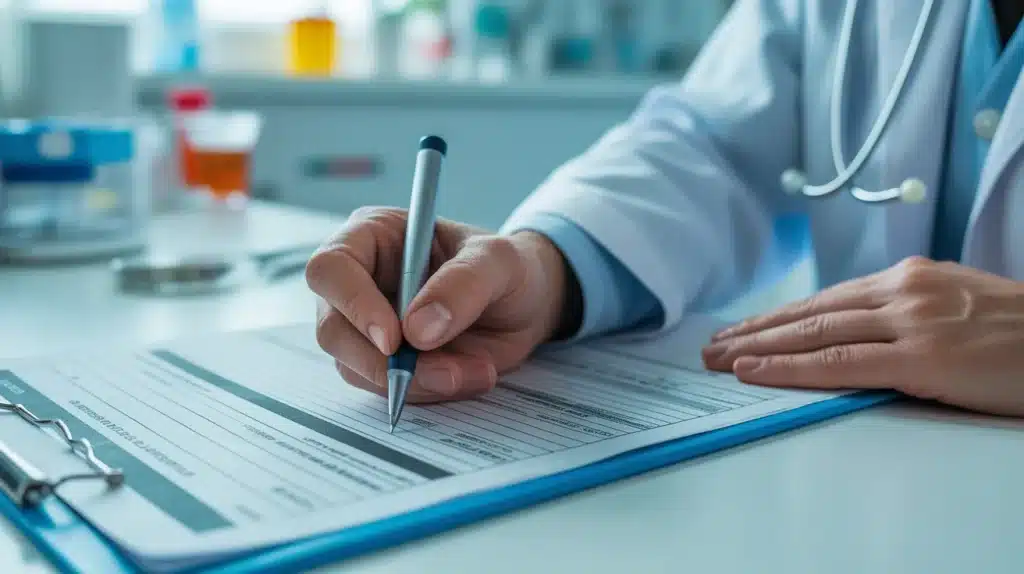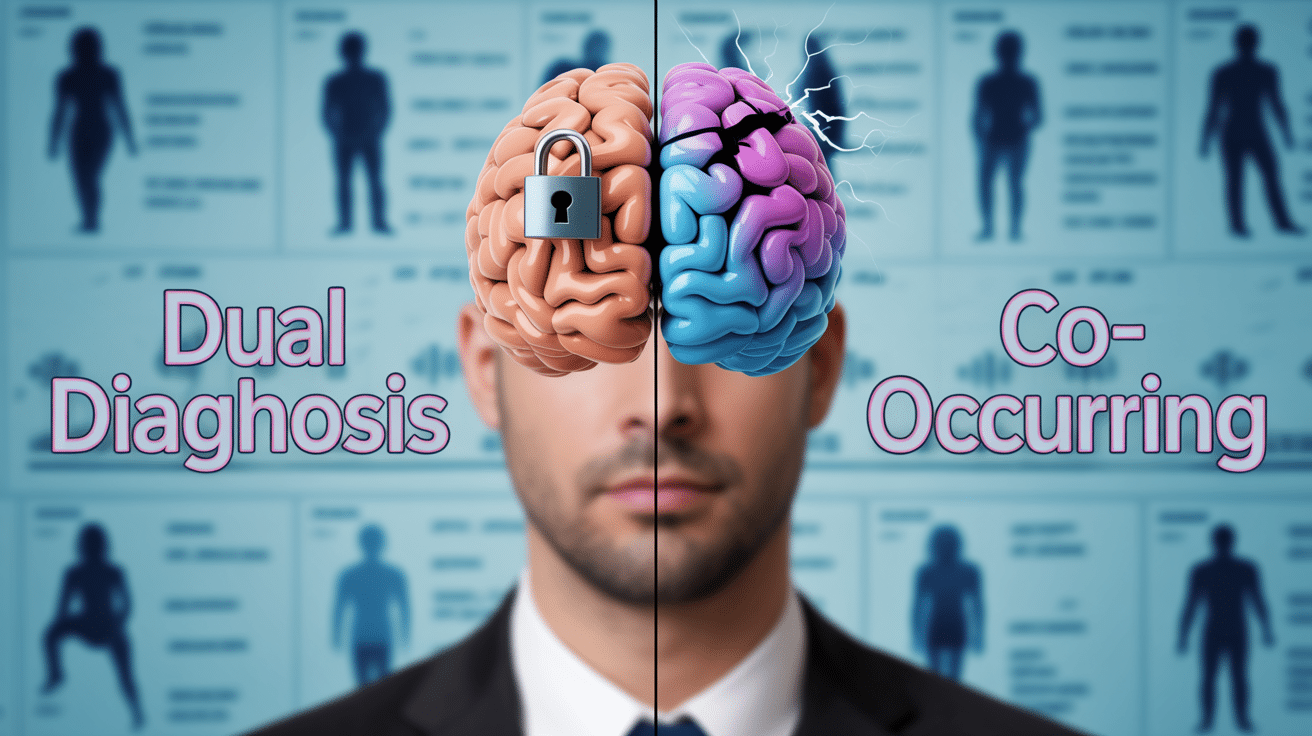Dual Diagnosis vs Co Occurring Disorders
Clear Definitions That Distinguish Dual Diagnosis From Co-Occurring Disorders In Plain Language
Many readers wonder if these phrases mean different things. In most health settings, they refer to the same situation. A person has a mental disorder and substance abuse at the same time.
How These Terms Are Used By Clinicians, Insurers, And Programs In Everyday Health Care
Clinicians record each diagnosis to show comorbidity. Insurers and programs may favor one label for forms or authorizations. Your treatment plan should address both conditions regardless of the term used.

Why The Language Matters For Patients, Families, And Health Outcomes Across The Full Care Journey
Words guide expectations, referrals, and speed of care. Accurate labels help psychiatry, therapy, and medication decisions. Clear terms also shape family support and recovery goals.
Mental Health Conditions Most Often Present In Dual Diagnosis Cases Across Age Groups And Settings
Common partners include major depressive disorder, anxiety disorder, and mood disorder. Bipolar disorder, schizophrenia, and borderline personality disorder also appear. Insomnia and panic disorder can complicate evaluation.
Key Features That Separate Anxiety, Panic Disorder, And Major Depressive Disorder During Substance Use
Anxiety can look like withdrawal or stimulant after-effects. Panic disorder brings sudden fear, chest tightness, and racing heart. Depression lowers energy, sleep, and motivation and may be misread as intoxication fatigue.
When Mood Disorder Means Bipolar Disorder And How That Diagnosis Changes Substance Use Risks
Mania can increase impulsive spending, travel, or alcohol use. Depressive phases can drive isolation and relapse risk. Tracking cycles helps match medication and therapy to real patterns.
Substances That Commonly Co-Occur And The Added Risks They Create For Mental Illness And Recovery
Alcohol and opioid misuse are frequent in co-occurring cases. Stimulants and sedatives also appear and change sleep and mood. Any substance can worsen symptoms and raise relapse odds.
Alcohol, Opioid, And Stimulant Patterns That Complicate Diagnosis, Medication Safety, And Therapy Planning
Alcohol disturbs sleep and raises depression risk. Opioid misuse dulls pain but can deepen anxiety and insomnia on withdrawal. Stimulants may blur attention and trigger panic or irritability.

How Comorbidity Can Blur Symptoms And Delay A Correct Diagnosis During Intoxication And Withdrawal Windows
Substance effects can mimic mental health disorders. Timing of symptoms relative to use gives key clues. Care teams separate primary disorders from substance-induced conditions.
Practical Ways To Tell Substance Effects From A Primary Mental Disorder Using Simple Timelines
List last use, peak effects, and withdrawal windows. Note which symptoms appear only during use or crash periods. Persisting symptoms outside those windows point to a primary mental illness.
The Disease Model And Why It Explains Behavior, Relapse, And Realistic Hope For Long-Term Recovery
Addiction and many mental disorders behave like a disease in the brain. Biology, stress, and environment shape behavior. Treatment and support change outcomes over time.
What This Model Means For Therapy, Medication, And Day-To-Day Coping Skills That People Can Practice
The model supports structured therapy and medication when indicated. It normalizes steady follow-up and stress management. It frames relapse as a risk that skills and planning can reduce.
Building An Integrated Treatment Plan That Treats Both Conditions At Once For Safer, Faster Progress
Treating one condition alone leaves gaps. Integrated care aligns psychiatry, therapy, and support in one plan. This approach improves health, function, and safety.
Therapy Approaches That Support Behavior Change, Skills Training, And Stress Management For Daily Stability
Cognitive and behavioral therapies build coping and relapse prevention. Skills work targets anxiety, insomnia, and mood swings. Family sessions add support and align home routines.
Medication Choices, Safety Checks, And Monitoring In Co-Occurring Disorders To Reduce Risks And Side Effects
Psychiatry may use antidepressants for depression and anxiety. Mood stabilizers can reduce bipolar disorder swings that fuel use. Teams monitor dose, interactions with alcohol or opioid misuse, and side effects.
Risks Of Untreated Dual Needs And Signals Families Should Watch Closely To Prevent Escalation
Untreated comorbidity drives relapse and crisis. Work, school, and relationships suffer under stress. Medical risks rise when substance use hides a worsening mental illness.
Relapse Patterns, Insomnia Triggers, And Simple Safety Steps That Work When Warning Signs Emerge
Relapse follows periods of conflict, sleep loss, or missed medication. Insomnia raises cravings and anxiety. Early check-ins, safe rides, and calm language reduce harm.
Working With Specific Diagnoses That Raise Unique Treatment Challenges And Require Focused Supports
Borderline personality disorder can intensify urges and fast reactions. Schizophrenia adds risks with missed medication and stress. Each diagnosis needs clear routines and reliable support.
Borderline Personality Disorder: Emotion Regulation, Impulsivity, And Substance Abuse With Skills That Make Life Safer
Emotion shifts can lead to use for quick relief. Therapy builds regulation, distress tolerance, and relationship skills. Crisis cards and daily practice help patients act before urges peak.
Schizophrenia: Adherence, Structure, And Protecting Stability In Daily Life While Reducing Substance Triggers
Substance use can worsen psychosis and memory problems. Visual reminders, transport help, and regular sleep protect stability. Family support improves follow-through and appointment attendance.
Daily Skills That Lower Stress, Strengthen Coping, And Protect Recovery During Real-World Pressures
Small habits stack up over time. Routines reduce decision fatigue and lower risk. Written plans help the brain under pressure.
Sleep, Activation, And Micro-Habits That Support The Mind And Brain Without Adding Extra Stress
Keep a fixed wake time and darken the room at night. Use five-minute activation to fight depression and build momentum. Pair micro-rewards with each step to reinforce behavior change.

How Families And Communities Provide Support Without Increasing Stress, Conflict, Or Relapse Risk
Families can reduce triggers by removing substances at home. Clear boundaries keep expectations simple. Community groups offer education and steady support.
Clear Communication, Boundaries, And Home Changes That Reduce Triggers And Strengthen Follow-Through
Use short statements, kind tone, and written plans. Agree on transport, reminders, and safe storage for medications. Share key information with the care team during visits.
How Addiction Interventions Helps Families Move From Crisis To Coordinated Care With Integrated Dual Diagnosis Support
Addiction Interventions connects families to evaluation and the right level of care. We coordinate psychiatry, therapy, and placement with dual diagnosis programs. We support transport, admission, and early relapse prevention.
What To Expect From First Call Through Placement And Early Follow-Up When You Work With Our Team
We start with a clear review of mental health issues and substance use. We verify insurance, align with programs, and secure a safe plan. We maintain contact through the first weeks to support recovery steps.
Frequently Confused Terms And A Quick Glossary For Faster Understanding Of Mental Health And Addiction Labels
Mental illness refers to diagnosable mental health conditions. Mental health disorders and mental disorders are common variants. All affect thinking, mood, or behavior and need care.
Short Glossary With Plain Definitions That Clarify Comorbidity, Diagnosis, And Treatment Language
Comorbidity means two or more conditions at the same time. Dual diagnosis and co-occurring disorders both mean mental illness plus substance use. Diagnosis is the label based on symptoms, duration, and impact.
When To Seek Urgent Help And What To Do In The First Ten Minutes To Protect Life And Safety
Call emergency services if there is danger to self or others. Use urgent care for severe symptoms or intoxication with medical risks. Safety comes first, then follow with the treatment team.
Information To Gather For Responders And Psychiatry During A Crisis To Speed Stabilization And Care
List medications, doses, and last use times for each substance. Share diagnoses such as bipolar disorder, schizophrenia, or anxiety disorder. Have insurance and contact details ready for health care staff.
Next Steps You Can Take Today To Start Recovery And Reduce Risk While Building Confidence In The Process
Make one call and one plan today. Schedule an evaluation and share a written symptom and use timeline. Ask a trusted support to join that visit.
Contact Addiction Interventions For A Dual Diagnosis Intervention And Care Match That Respects Safety, Timing, And Fit
We help families organize an intervention and select the right setting. We work with programs that treat mental health conditions and addiction together. Reach out to start recovery steps now.
FAQs
- Which Term Is Better For Insurance—Dual Diagnosis Or Co-Occurring Disorders?
Most plans accept both if documentation shows comorbidity. The key is accurate diagnosis and medical necessity. Ask the clinician to include timing of symptoms and risks. - Can Medication Help If I Keep Drinking Or Using Opioids During Treatment?
Medication can help, but safety drops when alcohol or opioid misuse continues. Clinicians may adjust timing, dose, or choice. Integrated therapy increases success and reduces relapse. - How Do I Handle Insomnia Without Triggering Relapse Or Anxiety Spikes?
Use fixed wake times, dark rooms, and device limits. Avoid alcohol and late caffeine. Ask about behavioral sleep strategies before adding a new medication. - What If My Symptoms Only Show Up During Withdrawal—Is That A Mental Disorder?
If symptoms occur only in intoxication or withdrawal windows, they may be substance-induced. Track timing carefully with your therapist. Persistent symptoms outside those windows suggest a primary mental illness.

